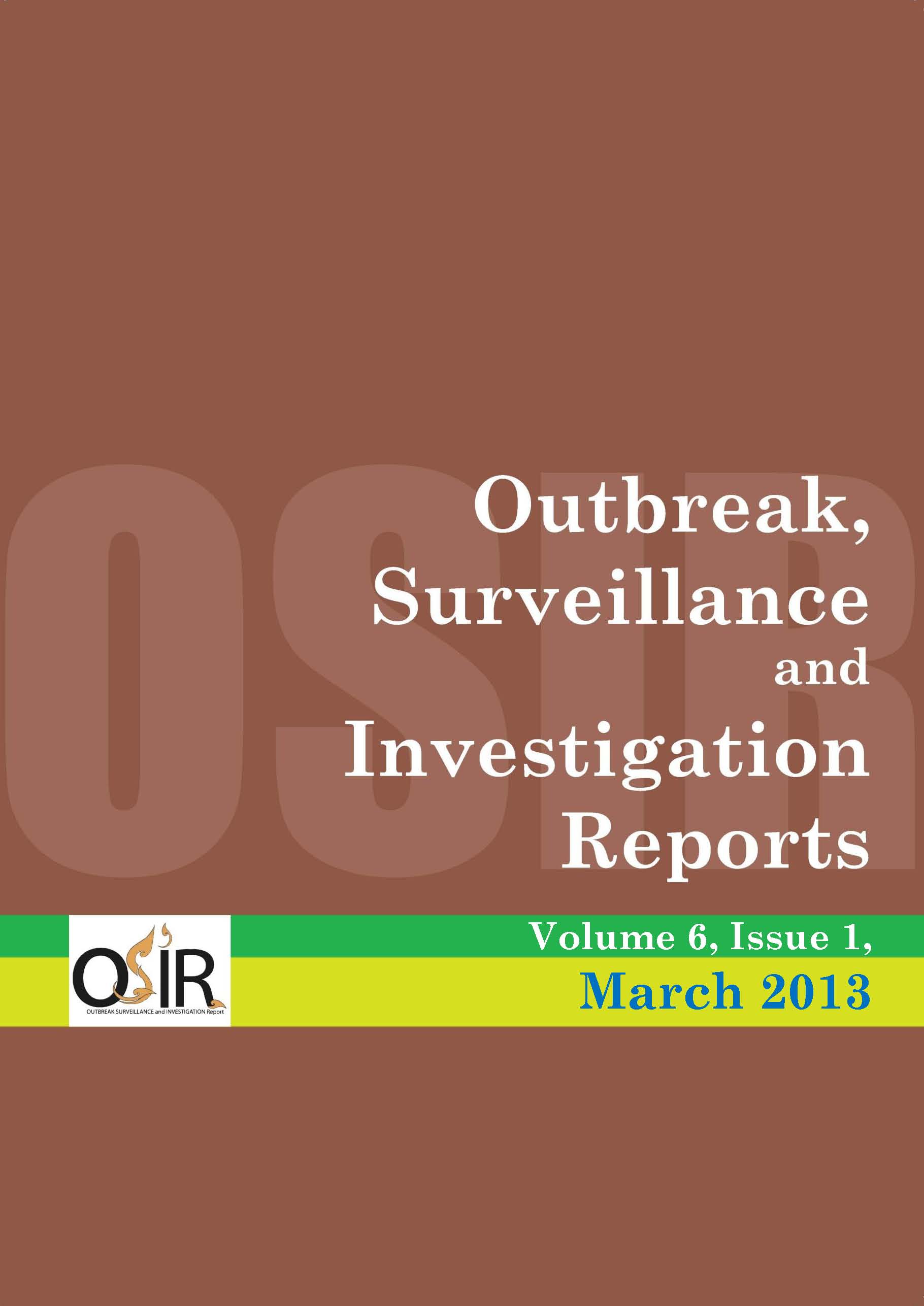An Evaluation of Influenza-like Illness (ILI) Epidemic Alert Thresholds in Two Provinces of Thailand, 2007-2010
DOI:
https://doi.org/10.59096/osir.v6i1.263341Keywords:
influenza-like illness (ILI), epidemic alert threshold, cumulative sumAbstract
Following introduction of influenza A (H1N1) pdm09 in Thailand during 2009, the national influenza-like illness (ILI) reporting system and short message alert signals was established by the Thailand Bureau of Epidemiology as a tool for early detection of influenza outbreaks. However, no specific threshold for determining the epidemic alert status existed. The objectives of this study were to determine baseline and epidemic alert thresholds of ILI proportions for different hospital sizes. The study was conducted in nine hospitals (three small, three medium and three large hospitals) in two provinces of Nakhon Ratchasima and Nakhon Si Thammarat. We reviewed hospital databases and collected data on ILI and all hospital visits during 2007-2010 from hospital databases. Then, we calculated mean, median and standard deviation (SD) of the weekly ILI proportions by hospital size over the 4-year period. We also used the Early Aberration Reporting System (EARS-X v2.8) to determine an aberration from baseline by calculating cumulative sum (CUSUM) by hospital types. We found that large hospitals had baseline ILI proportion lower than medium hospitals while baseline ILI proportion of medium hospitals was lower than that of small hospitals. The seasonality of the peak ILI proportions in 2009-2010 was different from pre-pandemic years of 2007-2008. Mean and median ILI proportions before the pandemic were lower than that of after the pandemic. Among individual hospitals, weekly ILI reporting was highly varied which prevented the use of CUSUM analyses. Aggregate reporting from several hospitals produced more reliable data for CUSUM analyses. No single signal in the EARS-X v2.8 software reliably predicted increased flu activity without signaling many false alerts. However, the combination of signals in the software reliably predicted the start of flu season with rare false alerts. We concluded that in Thailand, the baseline ILI proportion depended on hospital size. Due to variability in reporting from individual hospitals, we suggested choosing a method of epidemic alert threshold detection by level of health facilities using the CUSUM technique at the national level and median + 2 SD method at the hospital level.
References
Centers for Disease Control and Prevention. 2009 pandemic influenza A (H1N1) virus infections - Chicago, Illinois, April-July 2009. MMWR Morb Mortal Wkly Rep. 2009 Aug 28;58(33):913-8.
World Health Organization. World now at the start of 2009 influenza pandemic. 2009. [cited 20 Feb 2013]. <http://www.who.int/mediacentre/news/statements/2009/h1n1_pandemic_phase6_20090611/en/>
Iamsirithaworn S, Akarasewi P, Yingyong T, Suthachana S, Pittayawonganon C, Ungchusak K. Three waves of the 2009 H1N1 influenza pandemic in Thailand. Siriraj Med J. 2011;63:64-67.
Thailand. Bureau of Epidemiology, Department of Disease Control. Influenza like illness (ILI) surveillance system. [cited 10 Feb 2013]. <http://164.115.5.58/ili/>
Heymann DL. Control of communicable diseases manual. 19th ed. Washington DC: American Public Health Association, 2008.
World Health Organization. WHO interim global epidemiological surveillance standards for influenza. 2012 July. [cited 10 Feb 2013]. <http://www.who.int/influenza/resources/documents/INFSURVMANUAL.pdf >
Centers for Disease Control and Prevention. Emergency preparedness and response. Early Aberration Reporting System. 2012 Sep 19. [cited 10 Feb 2013]. <http://www.bt.cdc.gov/surveillance/ears/>
Hutwagner LC, Thompson WW, Seeman GM, Treadwell T. A simulation model for assessing aberration detection methods used in public health surveillance for systems with limited baselines. Stat Med. 2005 Feb 28;24(4):543-50.
ASEAN Institute for Health Development. Management challenges: urban primary care network. Thai. [cited 10 Feb 2013]. <http://www.aihd.mahidol.ac.th/rcenter/content/การจัดการความท้าทาย-เครือข่ายบริการปฐมภูมิเขตเมือง.>
Henning KJ. Overview of syndrome surveillance. What is syndrome surveillance? MMWR Morb Mortal Wkly Rep. 2004 Sep 24;53(Suppl):5-11.
World Health Organization. Systems for the early detection of malaria epidemics in Africa. An analysis of current practices and future priorities. 2006. [cited 10 Feb 2013]. <http://www.who.int/malaria/publications/atoz/9789241594882/en/index.html>
Downloads
Published
How to Cite
Issue
Section
License
Copyright (c) 2023 Outbreak, Surveillance, Investigation & Response (OSIR) Journal

This work is licensed under a Creative Commons Attribution-NonCommercial-NoDerivatives 4.0 International License.









